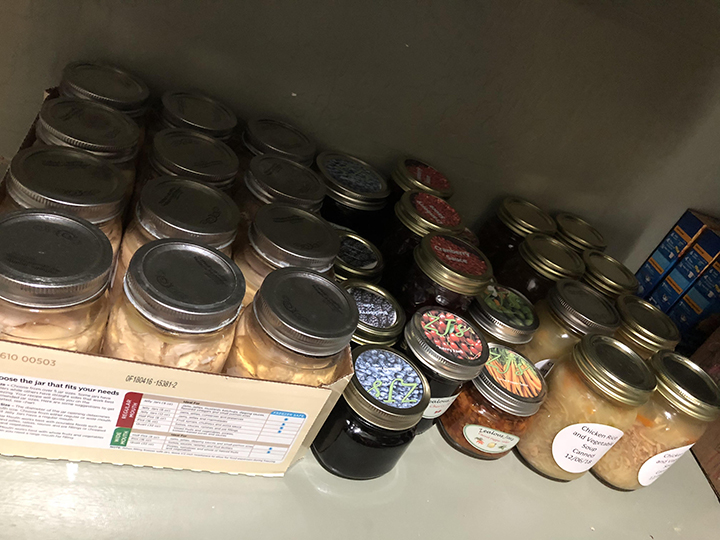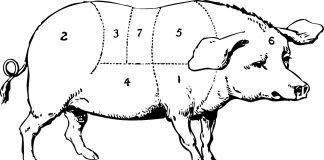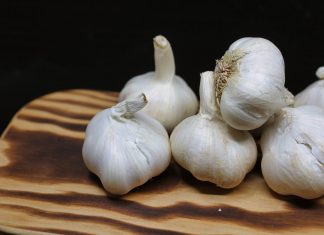 |
|
| Issue #55 • January/February, 1999 |
All self-reliant families know they should have at least a year’s worth of food and essential supplies stored up in a large pantry. Unfortunately, actually eating from long-term food storage conjures up images of consuming endless tedious, tasteless meals of boiled rice and beans. You know”survival” food.
|
But this is not how my household works. If I were to serve such meals, there would be total rebellion. After all, we’ve had at least two years’ food stored for twenty years, and we eat daily from this food. We are not martyrs, and we do not eat tasteless food in order to be “healthy.” Instead, we eat three meals a day from good tasting, comforting, healthy food, much of it home-raised, home-grown or harvested from the wild.
With a little practice and imagination, any family can quickly learn to produce meals, drawn from your food storage, that draw rave reviews from family members. And you do not need to spend hours in food preparation time either.
Buying for long-term food storage
A lot of problems arise when a family purchases foods they are not used to eating, and are not especially fond of in the first place. During hard times, or in an emergency, are definitely not times to begin eating such “survival” food. When you’re stressed out, worried, and depressed, you need a lift, not countless meals of boring, tasteless food.
Take stock of the foods your family really likes. Then build your storage pantry on these preferences. Just about anything you regularly eat can be included. One notable exception is hamburgers and cheeseburgers. You can home can hamburgers, by lightly frying tiny patties, then stacking them into wide mouth jars. I do a few, just for novelty, layered with finely chopped onion. When ready to use, refry them, adding cheese if desired. They’re good, but aren’t the same as the regular hamburgers the family is used to. And there isn’t an alternative to home canned hamburger available for purchase.
Have your family go through the supermarket with you and take notes as to what interests them, even if you have not cooked it before, or recently. You need variety in your long-term storage foods. Meals are like buildings. They need foundation blocks like potatoes, rice or beans, but also windows and doorways like fruits, meats, vegetables, and spices.
Choose the foods carefully, taking into consideration those you use daily or would use, if you had the time….and had no alternatives. Two frequently overlooked items are shortening/margerine and eggs. And make sure there are plenty of opportunities for “goodies,” such as cookies, pies, puddings, Jello, etc.
Introducing the family to seldom-used staples
There’s a definite place in a long-term storage pantry for such staples as dried beans and rice, but instead of buying all navy beans and white rice, consider that there are over a dozen varieties of beans and perhaps six varieties of rice available, each with its own unique taste, texture, appearance, and uses. In our pantry, I have many kinds of beans which we use: navy, red kidney, pinto, Anasazzi, black, and several varieties of Native American beans that we grow at home. You might include a couple of limas (which our family just does not like), cowpeas, Great Northerns, or others.
Then try a few really good recipes and gently ask all family members to try just one small serving with a meal they love.
Work your way into beans. Don’t just cook up a huge pot and insist everyone eat them for a meal. You can “sneak” beans into meals by mashing cooked pintos in with taco filling, putting a few mashed beans in a layer of casserole, or into a hearty vegetable stew or soup.
Old-fashioned baked beans, complete with ham or bacon chunks, molasses and catsup will usually do the trick on a cold winter’s day.
When cooking from a long-term storage pantry, learn to buy or home-can meat in smaller cans and jars. This allows one to use the meat as flavoring and texture to a meal, making a little go a long way, and not give the impression of “making do” or “surviving.”
A couple of examples that we regularly use are Oriental Chicken Fried Rice and Tamale Pie. I never have leftovers.
|
||
|
The same with rice. Few people like a big plate full of steamed white rice. “I don’t like rice!” is the usual comment. My answer is get to know rice and all its uses.
Perhaps the easiest way to interest a family member in rice is to serve Oriental fried rice, complete with little chunks of chicken or pork. Spanish rice is another interesting way of introducing rice into a meal. The point is to introduce staples gently into meals, before called on to use them every day.
|
The use of ethnic meals is a great way to introduce a family to basics, as most less-wealthy nations have fabulous recipes, using cheaper staples as the base for meals. You can learn to do wonders with corn flour and corn meal, beans and chiles, rice, vegetables, sauces, and bits of meat, potatoes, and vegetables. I quickly learned that America is one of the few nations in the world where meat is used as the foundation of a meal. (We had adopted two older children from India and three from Korea, as well as sponsoring a family of nine from Vietnam.)
Such goodies as homemade pizza are always hits at home, especially in an emergency or hard-times situation. Key ingredients, such as pepperoni and mozzarella cheese, are in few long-term storage pantries. When one has their own dairy animal, the cheese is a snap, and dry-cured pepperoni lasts for months without refrigeration under cool, dry conditions. I also have canned chunks of pepperoni and am going to try mozzarella cheese too. But without these options, pizza is still a definite “go”. Check out recipe above.
But we’ll miss fried foods!
I think one of the things a family misses most, living totally from a long-term storage pantry, is simple fried foods. Now this can have an up side, as well as a down. The fewer
the fried foods consumed, the better health we enjoy. But, honestly speaking, some fried foods do a lot to boost our morale during rough times.
Now, of course, if a family has their own garden, which a self-reliant family should have anyway, they will have abundant potatoes, fresh or in the cellar. If not, you can fry up a batch of canned potatoes, from time to time, or make potato patties out of leftover mashed potatoes (adding two beaten eggs to hold them together). There are also dehydrated and freeze-dried hashbrowns that are quite good.
One satisfying, simple recipe we enjoy from our pantry is fried tuna patties. This provides meat, as well as satisfying
an occasional craving for “fried food.”
Roast beef hash is another “alternative” fried food. Unless fresh meat, either home grown or wild, is available, there will be little fried meat available.
One of the home storage pantry’s best capabilities is providing quick, nutritious soups and stews at quick notice. These include those using pasta and noodles, as well as the more traditional.
One of our favorites is homemade noodles, cooked with chicken broth. You can use store-bought noodles, but there is absolutely no comparison in taste or texture. And noodles are very easy to make, only taking a few minutes once you get the hang of it. Even “mistakes” are very edible.
Breads
Don’t forget the staff of life. Breads provide an endless base to home meals, unlike their tasteless plastic wrapped cousins from the store. On one camping trip, we made an entire meal out of a crispy, fragrant loaf of French bread, without a dab of butter.
Breads can be made of varying flours for entirely different tastes, textures, and appearances. Aside from the “normal” white flour from the store, one can, and should, grind their own grains, producing a wide, wonderful, array of fresh flours. This produces a wholesome taste that most folks have never even dreamed of.
As all grains store much longer as whole grains, it is wise to stock up on these grains and grind the flours as you need them. Some suggestions are red and golden hard wheat for bread, soft wheat for pastries, flour corn for cornmeal, hominy corn for corn flour, buckwheat for pancake flour, rye for rye and pumpernickel bread, and rice for Asian cooking.
You will find that when you are cooking solely from the long-term storage pantry under times of duress, just the milling of the flour and baking of bread will bring peace and contentment to the whole family.
While “plain” bread will probably be most often used, stretch your creativity by expanding to more “exotic” breads such as pitas, tortillas, and sweet rolls, both for taste and variety. Most use about the same simple ingredients, and with just a little variation you can create a whole spectrum of tastes and possibilities.
One of our favorite breads is a versatile quick roll recipe. This recipe makes soft, tender dinner rolls, but also free-form breads, hamburger buns, sweet rolls, and coffee cake with little change.
Tips for cooking from home storage
Cooking from a long-term storage pantry is easy, basic, and very fulfilling. But it is not something one learns to do overnight. It’s sort of like gardening. The time to learn to garden is not when the trucks stop hauling food to supermarkets and there are acute food shortages. It takes time to get into the rhythm of gardening, learning what works, what does not, and how to do the most work with the least effort.
When a person plunges into cooking solely from home storage, they are quite often frustrated by “all the hard work,” the poor results from their cooking, and the lack of enthusiasm from family members. Sort of like when a new young bride begins cooking for her husband for the first time. The results are often ho-hum.
Try taking one day a week, at first, to practice cooking out of your storage pantry. Ease into it with a few of these recipes; they are easy and basic. Then expand to others, found in some of the books listed below. Mennonite, Amish, Mormon, and Seventh Day Adventist cookbooks usually provide a good start for comforting, tasty meals with basics, as these religions stress commonsense preparedness and good family eating from basic, healthy ingredients.
It’s well to mention at this time that it makes good sense to develop a small garden, at least, and learn to forage for wild foods (which are great tasting, by the way), while learning to cook meals from the food you have stored. Fresh foods are a very welcome change to dehydrated and canned, and they not only taste great, but provide extra nutrition, which could conceivably be lacking in a few long-term storage foods.
Likewise, if it is at all possible, develop your own sourceof fresh milk, eggs, and meat. Grandmas all over the world raised a small flock of chickens, even in town. It’s funny that the U.S. is one of the few countries where this is not common today. Remember that variety is truly the spice of life; cultivate all the variety you can in your family’s diet.
You’ll find you get into the rhythm of this type of cooking easily. And you’ll quickly develop time-saving ways of doing things. For instance, it didn’t take me long to decide that if I ground a week’s worth of grains I truly saved time, and cleaning of the grain mill, and I always had the grain I needed on hand conveniently.
I can honestly say that it takes only minutes longer per meal to prepare a great dining experience from my pantry than it does to rip and pry plastic wrap from something that appears to be food. And it makes the whole family feel great. We believe in living, not just surviving!
Suggested Reading
Amish Country Cookingby Andy & Millie Yoder
Bread Winnersby Mel London
Cookin’ with Home Storageby Vicki Tate
Dehydrated Food Cookingby Stan Smith
Kitchen Magic-Cooking with Common Grainsby Deanna Sudweeks
Marlene’s Magic with Food Storageby Marlene Peterson
The Natural Nine(Cooking with the 9 most common grains) By Lorraine D. Tyler















What a wonderful article, Jackie. I have a few questions for you: Can I use lard instead of shortening, to fry? Can you finish your instructions about “canning” hamburger patties? in a pressure cooker, what lbs, and how long? Could you elaborate what native American beans are? naming them, please? What do the letters TVP mean? I really liked your advice in the article. Thanks so much.
Great article!